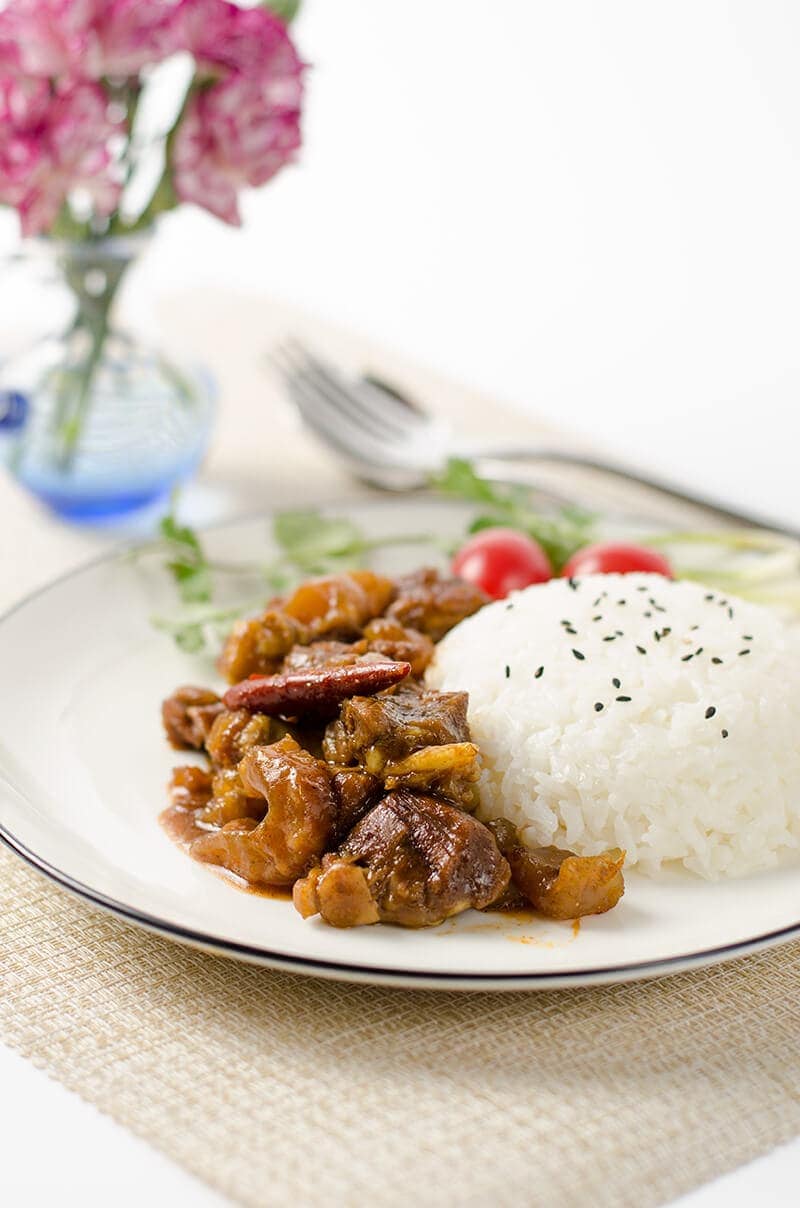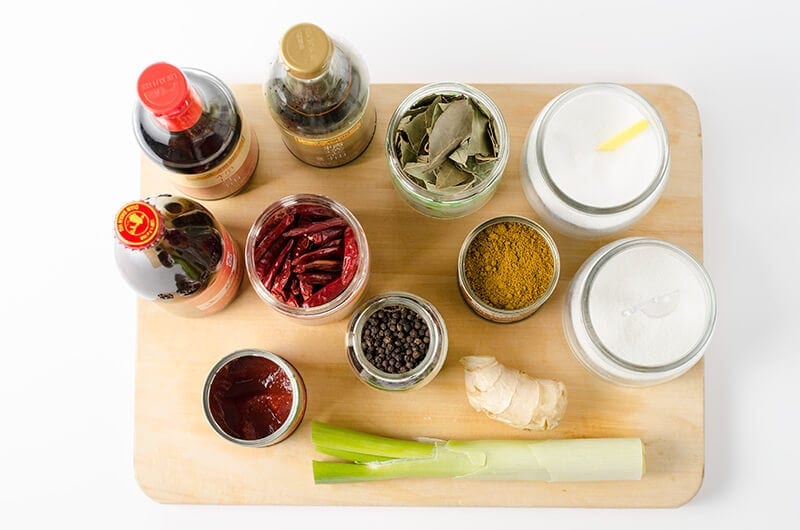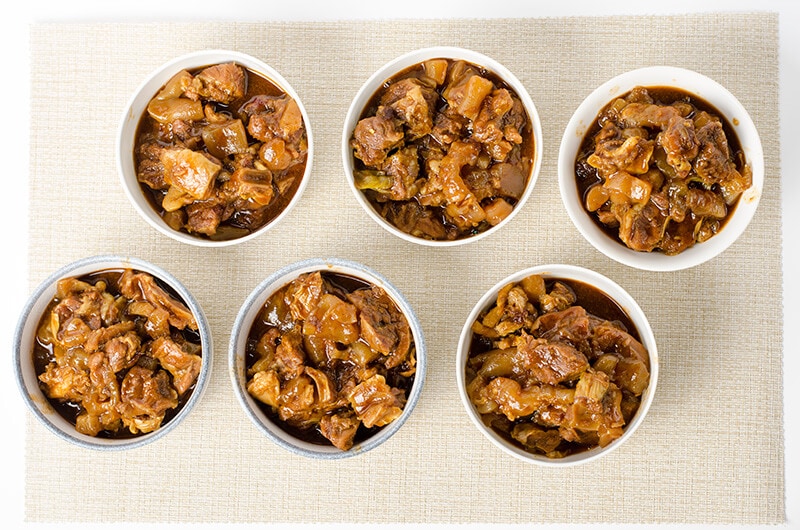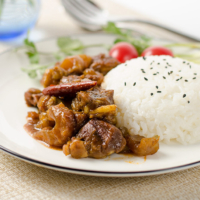
This beef stew uses soy sauce, wine, bay leaves, chili, curry powder, and tomato paste to create a balanced and rich flavor without overpowering the taste of the beef. None of the spices stands out too much. It’s neither a curry nor tomato flavored dish, but tastes much better than the combination of the two.
Although most people from the US and Europe find it unappealing, beef tendon is a favorite cut in Asian cuisines. Why on earth would you put beef tendon in stew? The short answer – it’s delicious. The long answer – if cooked properly, beef tendon becomes tender and moist. Some of the tendon will even dissolve into the broth, which increases the richness and creaminess of the stew and contributes wonderfully to the flavor. The final result is a literal melt-in-your mouth sensation. This recipe teaches a good way to cook beef tendon, one that makes beef stew taste even better.

If by any chance you get your hands on some beef tendon, instead of writing it off as inedible and throwing it away, you could try experimenting with it by following the recipe below.
On the other hand, if you have a really strong aversion toward beef tendon, you can still use this recipe without the tendon. This will still result in a very flavorful and rich Asian style beef stew.

Before jumping into the recipe, here are a few tips that will help you prepare this dish properly:
1) Boil the tendon and discard the boiling water before braising. This is a must. Raw beef tendon is quite smelly. If you cook it in a dish directly, the dish will end up with an unpleasant (even stinky) smell.
2) Simmer the tendon in a pressure cooker for 30 minutes to reduce braising time. The tendon part is so tough that it takes many hours to braising on stove top.
3) Boil the beef before braising and save the broth. I like to keep the broth because it’s quite flavorful. However, if the broth smells bad (due to the freshness of the beef), discard it and use fresh water for the braising process.
4) Only add non-salty spices in the beginning. Add salty spices (including soy sauce) when the beef starts to get tender, about half way through the braising process. If you add salt at the beginning, it will toughen up the beef and require more braising time.
5) Use enough broth to cover the beef, and simmer on low heat until the beef becomes soft, then turn up the heat to reduce the broth toward the end. If the broth is reduced too much, it will get thick very fast and start to burn at the bottom of the skillet (or wok). Don’t forget to stir the stew several times while simmering, and add extra broth if needed.
6) Store the stew in small containers in the freezer after the stew has cooled down. You can enjoy the stew whenever you want, during the week or packed for lunch. For a quick dinner, simply throw in some vegetables (carrot, potato, broccoli etc.) into the stew and boil them together. A healthy and filling stew will be ready on your table in less than 30 minutes.

This is one of the recipes from my Mom’s Best series. In this series, I collect family recipes handed down from my grandma to my dad, then to my mom, and now, to me. In the same series, you can also find Mom’s best braised pork spare ribs, Mom’s best braised pork feet, Mom’s best braised duck leg and Mom’s best braised chicken stew with mushrooms. More family recipes are on the way!
I also made a short video to walk you through the cooking process. It was the first time that I recorded a video with voice, and I was super nervous! I hope the video isn’t too awkward. 😉 Also, be sure to check out my cooking channel on YouTube. It contains a collection of videos which help you learn Chinese cooking skills in a straightforward way!

Mom's Best Beef Stew with Tendon
Ingredients
- 2.4 kilograms (5 pounds) beef plate , cut into bite-size cubes
- 0.8 kilograms (1.5 pounds) beef tendon , cut into bite-size cubes
- 4 tablespoons Shaoxing wine
- 6 chili peppers , dried
- 1 and 1/2 thumbnail ginger , divided into 3 thick slices, slightly smashed with a knife
- 15 centimeters (6 inches) scallion , chopped (2 centimeters /1 inches in length)
- 4 bay leaves
- 2 teaspoons whole black peppercorns
- 2 tablespoons curry powder
- 1 tablespoon sugar
- 4 tablespoons tomato paste
- 1 tablespoon dark soy sauce
- 2 tablespoons light soy sauce
- 4 teaspoons salt
Instructions
- Place beef tendon in a pressure cooker and add water to cover beef completely. Place on high heat until rated pressure has been reached. Turn to lowest heat. Simmer at rated pressure for 30 minutes. Turn off heat and allow the pressure to release naturally.
- While simmering the beef tendon, prepare beef plate. Add beef plate into a large pot and add water to cover the meat. Bring to a boil over high heat. Turn to medium-low heat and keep a gentle boil going for 10 to 15 minutes. While boiling, skim the foam from the top of the broth and discard it. Turn off heat. Use a colander to transfer beef to a wok (or a large dutch oven). Let the soup sit about 10 minutes, then pour the soup into the wok until it covers the beef completely. (There may be some clotted blood on the bottom of pot. Try to avoid pouring it into wok.) Save the rest of the soup in the pot and set it aside for later use.
- Heat the wok over medium heat. Add Shaoxing wine, chili pepper, ginger, scallion, bay leaves and black pepper (* see footnote) into wok and simmer, covered, for about 40 minutes. The beef tendon should be ready at that point.
- Transfer beef tendon from the pressure cooker to the wok, and discard the broth.
- Add curry powder, sugar and tomato paste into wok and mix well. Simmer, covered, for about 30 minutes, until beef starts to become more tender.
- Add dark soy sauce, light soy sauce and salt into the wok. Mix well and simmer, covered, for one hour to one hour and a half (simmer time varies depending on the cut of beef). While simmering, stir the beef several times. Scoop the beef from the bottom with a spatula, to avoid burning it on the bottom of the pot.
- After 20 minutes, watch the beef more closely and adjust the seasoning. If the liquid is becoming thick, but the beef is still tough, add more broth (from step 2), half a cup at a time. The liquid should be able to cover half of the beef. However, do not add too much water at the end of simmering, when beef is already soft.
- When simmering has finished, adjust the seasoning again. The beef should be very tender and the soup quite thick. If the soup is not thick enough, boil uncovered over medium heat. Stand near the wok and stir constantly until soup thickens.
- Serve warm with steamed rice.
- The beef stew will stay good in an airtight container in the fridge for up to a week, or in the freezer for up to a month.
- To store the beef stew for your lunchbox or dinner during the next two weeks, place stew in a small bowl (2 to 4 servings per bowl) and set aside. After the stew has cooled down to room temperature, cover with plastic wrap and place in refrigerator, until stew has congealed and can easily be easily taken from the bowl. Store the blocks of stew in individual ziplock bags in the freezer.
- To make a one-dish meal, you could add beans, potato, tomato, carrot or broccoli into the stew and boil them together, until the vegetables are cooked through.
Notes
- I used a mesh tea infuser ball to trap whole black pepper. It'll be easier to take them out after the braising and discard.













Sigh, this looks delicious. The Mr. would be ALL over it!! Your photos are so gorgeous Maggie, and love the videos, definitely signing up!
Hi Jessica, thanks for visiting! 🙂 Glad you like the video too. I’m still quite new to shoot and edit video and there’s so many things to learn!
Loved watching your video! My husband will especially enjoy this stew – he loves tendon! 🙂
Thanks Nami! I’m so relieved to hear this, because I thought tendon might sound weird to a lot of people.
First time to record voice in the video and I was super nervous… Think I’ll continue to do more silent ones, which easier for me.
I love beef tendon. It’s got that wonderful texture, kind of like beef fat–and as much as I love to eat huge chunks of fat, tendon is a much healthier option! I normally make beef tendon stew with five spice powder, but I want to try out these flavors as something different. I happen to have 1.25 lbs of beef tendons from a local farm (grass fed beef farm) so I’m going to try this out tomorrow!
I’m so glad to hear you like beef tendon too! It adds a lot of flavor to the stew, if you also add lean parts into it. Now it’s me turn to be jealous! Sometimes I can’t even find beef tendon in local market. Will go check and get a new batch of beef tendon soon. I’m getting very hungry after hearing you talk about it 🙂
Happy cooking and let me know how the dish turns out!
Hi Maggie,
Thanks for sharing this recipe and making your video so easy to follow. You have a lovely voice and I really enjoyed the way you narrated and edited the video. Thanks to you, I feel a little bit more confident to attempt this dish. My husband loves it, but I was too afraid to try it before you released this video. Many thanks!
So happy to hear that my video was helpful and your dish turns out well 🙂 And thanks for the kind words! I seldom speak in front of my camera because I’m not confident about my voice. So glad to know I sounded OK!
Have a great week ahead Caden!
I was going to make a pho stock in the Instant Pot with roasted soup bones (after I boiled off impurities)…would I treat the tendon the same way? Boil off the stinky impurities…roast…and pressure cook?
Just curious on your opinion.
Hi Mike, yes, you could treat the tendon the same way – boil once and discard the water. Then cook in the pressure cooker. Just be careful of the time you cook them in the pressure cooker. They will melt if being cooked too long.
Trying out your recipe now ?
But I’m astonished that the tendon broth is discarded – it makes for a very nutritious soup or stew that good for the joints and skin!
No disagree, beef tendon in most Asian cooking the broth is discarded. It has this strong odor that will ruin the stew. If you are talking about collegians she has enough of it in the other dishes like the braised pig feet, lamb rib pilov, And on her beef stock. I believe she is a model have you looked at her skin. If you have too much collegian it not healthy , it is very rich. It will raise your blood pressure and give you ache . As far as joints goes I am Pakistani we have eating stew with bones almost every dam day of my live, my parents can’t even walk right. And we have ears size of dumbo.
Do you have to wash tendons?
Just cook today, it s soo good,I love this this, turn out good fr your recipe, thank you
Hi Maggie,
Just recently came across your blog and have saved and going to try SO many of your recipes starting with this ONE!! but could you please advise if boiling the beef tendon initially without pressure cooker, would this just be ok to boil on high heat for the same 30 mins and discard water?
Thank you in advance
Michelle
Hi Michelle, I’m afraid boiling on stovetop for 30 mins won’t do the job. Beef tendon is very tough and requires much longer cooking time than beef. You will need to cook the tendon on stove for at least 1 hour 30 mins, or up to 2 hours. That’s how you make it super tender and it will almost melt into the broth at the end.
Thank you so much for clarifying the stovetop cooking time Maggie, absolutely can not wait to try this out! Really appreciate your posts!
No problem at all! Happy cooking and can’t wait to hear how your dish turns out 🙂
An excellent recipe with helpful tips throughout and a video of the process which I found so instructive of how to ensure success! Thank you for this … I tried this for Father’s Day and husband was so very delighted that he’s immediately requested a second batch!
Tendon is my 9-year-old’s absolute favorite pho addition. (And really, the whole family views it as the prized ingredient. We show it off every time we get a piece and no matter how much we’ve eaten, it’s inevitable that the other family members exclaim, “No fair!”) I showed him this recipe today and he was so excited. Now the only thing I’ve never heard of is beef plate – but suppose oxtail or some other cut of meat you typically braise would work well here if I can’t find it?
Hi Christine, the beef plate is a cut I used to get when I lived in China. I think they cut beef differently there so it’s probably hard to find.
Well marbled brisket and round roast will be great alternatives. Oxtail is the best if you want a fancier cut 🙂
Hi do you trim off the yellow fat on the tendons please?
I do not trim off the fat. It will eventually melt into the broth (I do skimp the broth once I’m done cooking).
Hi there – I want to make this for a big group of friends after skiing. Does this recipe really make 16-18 portions? I feel like they will want more than 1.5lbs of tendon between them! For a group of 12 would it be better to double or triple it?
I think the recipe is good for 12 people, but it depends on if this is the only dish you plan to serve. (about 6 pounds beef in total if plus the tendon, that means 1/2 pound per person, but the beef will shrink down quite a bit at the end of the cooking).
If you want more tendon, you can do 2 to 3 lbs tendon and reduce the beef. And if you’re not sure if the recipe is enough, doubling is should be plenty.
Hi Maggie,
My family has enjoyed so many of your recipes over the years. I am thrilled that you have so many instant pot recipes, as that is one of my favorite appliances. Do you have a way to adapt this whole recipe in the instant pot (not just the tendons)? I would love to shorten the braising time.
Hi, this looks so good and I wonder if I can cook it in a slow cooker instead? (I do not have a pressure cooker) Thanks!
I’m not super familiar with slow cooker but I think you can definitely try it. My only concern is the tendon, which will be still tough if you set the slow cooker on low. I would cook the tendon first on high, for 2 to 3 hours. Then add the rest of the beef and set on low, cook for 6 to 7 hours.